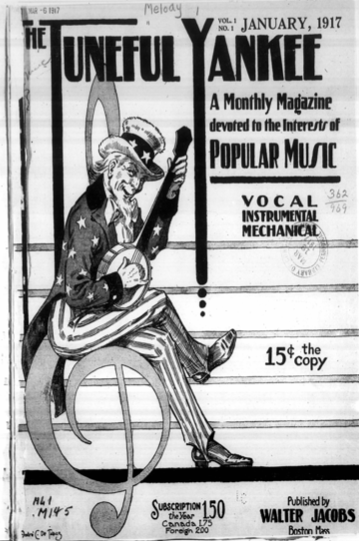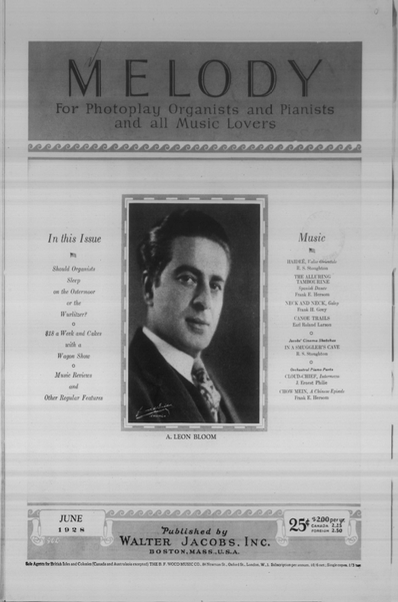The Tuneful Yankee and Melody Magazine: Documenting Popular Music in America from 1917 to 1930
by Kendra Preston Leonard, Founder and Executive Director of SFSMA
In 1917, the Boston-based Walter Jacobs Co., a sheet music publisher, began publishing a monthly periodical called The Tuneful Yankee. “Devoted to the interests of popular music,” as its subtitle declared, the journal included articles about new popular forms, such as ragtime and jazz; information about newly popular instruments, like the saxophone and banjo; reviews of new popular music and music for the silent cinema; and several pieces of sheet music in each issue. In January 1918, Jacobs changed the name of the magazine to Melody: a Monthly Magazine for Lovers of Popular Music and in January of 1925 changed the subtitle so that the journal became Melody: for the Photoplay Musician and the Musical Home. The subtitle changed yet again in January 1928, to indicate that Melody was not just for professional “Photoplay Organists and Pianists” but also for “all Music Lovers.”

The magazine offers a wealth of information for those researching American music during the period in which it was published. Staff writers and letter-writers provided reports from across the United States as to what music was being performed in the concert halls, cinemas, and dance halls in their cities and how it was received; reviewers offered critiques of the latest sheet music and recordings, especially those in the ragtime and jazz genres; biographies and interviews gave readers detailed information about how performers had found their niches and built their careers in popular music; and reports on music in schools documented contemporary music education. Editorials discussed issues of plagiarism and copyright, taste and innovation, and the role of music in society. Readers could also find advice on everything from learning basic composition to negotiating publishing and performance contracts. Gossip columns and other light fare gave readers a detailed insider look at the popular music business and its major players. While much of the magazine’s content speaks to those already employed as musicians in some capacity, it also contains articles, music, and advertisements designed to speak to aspiring professionals and amateurs.
The advertisements in Melody are just as valuable as the articles and sheet music. Scholars ca n trace the ways in which instruments were marketed; what repertoire was sold and in what formats and for what ensemble configurations; how songs were advertised and to what market targets; what kinds of training was offered (piano tuning, teaching, engraving, and piano and automated instrument salespeople, if the January 1925 issue serves as a representative example); and what items readers might need or want (music stands, chord charts for improvising cinema and dance hall musicians, electric blowers for organs).
n trace the ways in which instruments were marketed; what repertoire was sold and in what formats and for what ensemble configurations; how songs were advertised and to what market targets; what kinds of training was offered (piano tuning, teaching, engraving, and piano and automated instrument salespeople, if the January 1925 issue serves as a representative example); and what items readers might need or want (music stands, chord charts for improvising cinema and dance hall musicians, electric blowers for organs).
Melody is a particularly important source for tracing the development of music for the early American cinema and its creators and performers. Throughout its run, which ended with the July 1930 issue, Melody paid close attention to the business and art of the cinema musician, whose job it was to accompany features, cartoons, and newsreels in the motion picture theaters. The magazine’s editors hired well-known composers and performers in film music, including Harry Norman, Lloyd G. del Castillo, Norman Leigh, and George Cobb to write about film music and to contribute and curate pieces to include in each issue for use in the cinema. Nearly every issue had at least one article devoted to silent film music, and the magazine’s reviews of new popular music also included photoplay music. Regular columns on the activities of musicians in several large North American cities, including New York, Toronto, Denver, and Washington, D.C., provide a list of cinema musicians and their places of employment. It published several series of pieces composed specifically to be used in the cinema, including two dozen by Harry Norton that were later collected into one of Jacobs’s photoplay albums.
While it was a successful magazine it its time, Melody today exists as a full print run only at the Library of Congress, where it can be viewed in its microfilm format (Microfilm 86/20,101 Reels 1-7), although a handful of other libraries have partial volumes of the publication. Based on my research in the music libraries of several silent film musicians, it is clear that the music was often removed from each issue and stored separately from the rest of the magazine; this may have contributed to the lack of paper copies extant today. It has not been fully indexed before, nor has it been extensively studied as a resource for music scholars working in North American music in the early twentieth century. Thanks to the Music Library Association’s Dena Epstein Award, I was able to undertake research on Melody at the Library of Congress and have compiled indices for the journal, which will be available as open access materials online at Humanities Commons’s CORE repository and here on the SFSMA site. All of the sheet music that is in public domain will also be made available as open access materials here. I am please to partner with SFSMA to offer the full run of this important publication and indices to its compositions, composers, lyricists, and articles.
How to Use these Indices
These indices collect the titles and other information for the sheet music and feature articles published in The Tuneful Yankee and Melody. Each piece of music is indexed by title, composer, and date of issue. Articles are indexed by author, title, and date of issue. A number of articles do not have author names appended to them and are listed by title only. I have retained the original capitalization, spelling, and punctuation of titles, including the publication’s inconsistent use of “the.”
Pieces of music appear as Composer Last, First and collaborators (if any), followed by title, instruments, and finally, month, year and page. So an item from November 1918 by Norman Leigh appears as “Leigh, Norman. ‘The Fire-Fly And The Star. Scène de Ballet.’ Piano. Nov18: 14.” In many cases, pieces included in Melody were also published as sheet music in Jacobs’ various albums and collections of pieces. In these cases, I have also listed the series in which they were published.
Example: Larson, Earl Roland. “Winter Landscape.” Jacobs’ Cinema Sketches, vol. 4, no. 3. Piano. Sep27: 32.
Where the magazine provides the volume and number of these in the albums, I have also included it. In some cases, the music in the magazine appears to have gone to print before it was assigned to a specific volume or given a number. In these cases, I have just noted the series in which the piece was intended to become a part.
Melody Magazine Issues and Indices
An Index to The Tuneful Yankee and Melody Magazine (complete PDF)
The creation of these indices by Kendra Preston Leonard was supported by the Music Library Association’s Dena Epstein Award.
